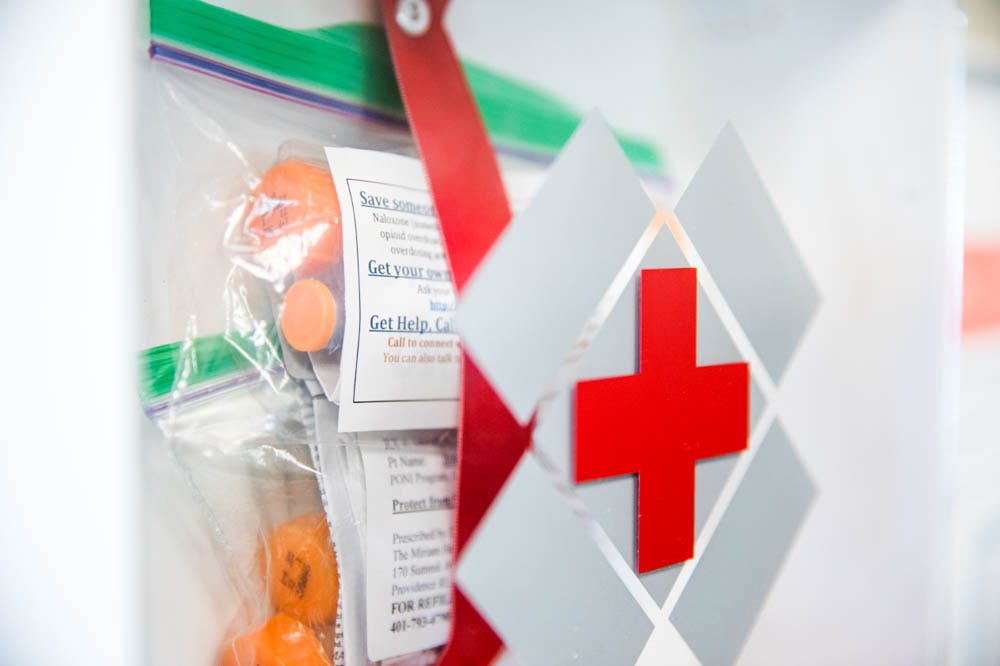Six months after the installation of Rhode Island’s first anti-overdose drug dispenser, around 50 additional NaloxBoxes have been installed in different municipalities and cities in the state, said Claudia Rebola, NaloxBox designer and former RISD professor.
The boxes, which distribute Naloxone, are meant to facilitate overdose rescues and reshape the dialogue surrounding the opioid crisis, said Dr. Geoffrey Capraro, pediatric emergency medicine sub-specialist and one of the NaloxBox’s creators.
The state saw 326 deaths from opioid overdoses in 2016, but the rate of opioid deaths in the state is slowing, according to a study conducted by the Center for Disease Control and Prevention.
“The epidemic is just raging out of control, and the antidote is completely life-saving,” Capraro said. “People (need to) recognize that a rescue is very easy to do and that anybody can do it. They could reverse the overdose before 911 services arrive.” Capraro likened Naloxone to other emergency response equipment, such as fire extinguishers or defibrillators.
The Rhode Island Department of Health initially funded the project with two mini-grants of around $5,000, said Joseph Wendelken, a public information officer at the Rhode Island Department of Health.
“With Naloxone available and the education that goes with it, we can get people into treatment sooner rather than later — and the more general awareness there is, the more likely there’s resources to combat the problem,” said Eileen Hayes, president and CEO of Amos House, a social-service agency where the first box was installed.
Organizations such as Amos House and the Rhode Island Coalition for the Homeless helped identify high-risk locations and communities for the boxes to be placed. Public spaces with large masses of people, community centers and locations with high-risk populations are the primary targets of installation, Hayes said.
While Naloxone can rapidly reverse an opioid overdose, it traditionally could only be administered by first responders in case of an emergency or obtained with a prescription, Capraro said. The placement of the Naloxone drug in a publicly-accessible box aims to respond to an overdose by equipping bystanders with the tools to save a life.
The project began in fall 2017 when Capraro connected with RISD Associate Professor Soojung Ham, who worked with two RISD students on an independent study of the NaloxBox. By February, Rebola took lead of the project and worked to reduce the cost of the prototype.
“(We look to) design a friendly, approachable product that doesn’t intimidate bystanders and empowers them,” she said, adding that the front door of the box is transparent so that passersby can easily see the contents.
Currently, the cost of each box — not including the Naloxone drug itself — is estimated to be around $200, Capraro said.
There are two versions of the NaloxBox: the “NaloxBox Classic,” which is the standard box, and the “NaloxBox Text,” which has all the features of the classic but also sends text message alerts to personnel when the boxes are opened, according to Rebola.
The boxes use two forms of Naloxone: the intramuscular formulation, which is injected, and the intranasal formulation, which is sprayed into a nostril. The injectable units require trained personnel, but are less costly than the sprayable units, Capraro said.
These injectable units are placed in locations such as libraries, soup kitchens and homeless centers where people can be trained to administer the drug. Training typically takes 15 to 20 minutes and covers different aspects of detecting and responding to an overdose.
Capraro hopes that NaloxBoxes spread to other states, but warns that others will have to understand the “regulatory framework” of Naloxone to adopt this solution, given that Naloxone is regulated differently state by state.
Rebola is currently introducing the NaloxBox to Cincinnati through a grant provided by the University of Cincinnati, where she now teaches. In Ohio, there were over 4,300 deaths from opioid overdoses in 2016.
Capraro and Rebola are still constructing the boxes, but Amos House will start assembling boxes to keep up with the demand, Hayes said. The Brown Opioid Academic Interest Group may also become involved with the project by having some members become trainers of Naloxone administration. The group also may work in conjunction with the Preventing Overdose and Naloxone Intervention program, as discussed in a recent conversation between the group and Capraro.
“We want people to know that even though drug addiction is a very difficult condition, people do recover successfully,” Capraro said.





